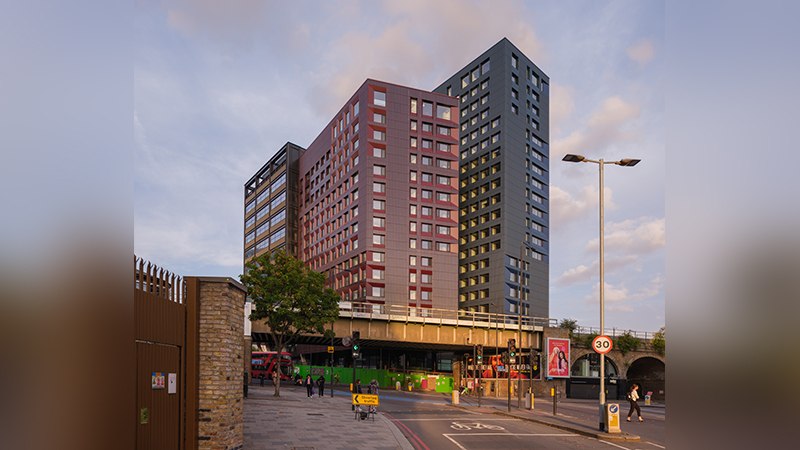Nine things you expected to happen in the UK this summer but didn’t
1 UK vote to remain in the EU
The obvious one. The faces of Brexiteers-in-chief Boris Johnson and Michael Gove when the result was announced said it all – they were stunned because they didn’t expect it to happen. Why would they? At 10pm on 23 June, and with no exit poll on which to base predictions, bookmaker Ladbrokes was implying a 92% probability of Remain. Within a couple of hours it was all too clear that the bookmakers, along with the establishment and the media, had significantly misjudged things.
2 Interest rate hike
Another widely tipped prediction to fall by the wayside. Instead, the Bank of England has cut base rates (the first change since 2009), moving further into unprecedented waters in response to Brexit. With bond yields falling to the lowest in history, yields on real estate now look attractive by comparison.
3 FTSE crashes
Post Brexit, the FTSE 100 has reached yearly highs, and is on course to set all-time records. Even the more domestically focused FTSE 250 has climbed above pre-referendum levels. While there have been some casualties, the story has been one of a big bounce, with exporters seeing some benefit from the currency movements.
4 Businesses desert the City of London
The initial reaction to the referendum result, at least outside property circles, was that this was an inevitability. As it transpires, most global occupiers have said that the result was insignificant to them, and just weeks after the vote Wells Fargo, the world’s biggest bank, signed a £300m deal to base its new European headquarters in London. Significant question marks over which European cities could actually accommodate large parts of London’s financial sector add weight to this position.
5 Deals at a standstill
The overwhelming majority of deals in the market on 23 June have proceeded as normal, especially in London, as investors conclude that fundamentals haven’t changed. Additionally, increasing interest has materialised from investors with dollar-denominated capital looking to take advantage of sterling’s devaluation.
6 Triggering of Article 50
Now considerably more famous than the preceding 49 articles, Article 50 has nonetheless been put on the backburner while everyone works out how to deal with a situation politicians across Europe didn’t see coming. David Davis had stated this would be served pre-Christmas, Theresa May seems more equivocal.
7 Retail sales slump
ONS data shows that retail sales for July were up by 1.6% on June, and by 3.6% on the equivalent July 2015 figure, as consumers shrug off concerns about Brexit. The month-on-month in-store growth rate is at its highest since December 2013, and the annual growth in online sales in running at 16.7%.
8 Manufacturing grinds to a halt
CBI survey results show that manufacturers’ order books have not been this full for two years, with 30% expecting a rise in levels of output next year.
9 Boris Johnson becomes PM
The less said the better…
By Richard Pickering, head of research and insight, UK and Ireland, Cushman & Wakefield
Five things you need to know about Norwegians
1 They say what they mean and they mean what they say
There is no such thing as tact in Norway. Direct, to the point and without the slightest hint of a sugar coating, a Norwegian will always tell you exactly what they think. “We are famously direct,” says Sverre Landmark, who heads up the marketing for one of the city’s biggest new developments. “Even the Swedes are more gentle with what they say. We just say it. Whatever it might be. If we don’t think something is good, we will say so. It can make us come across as rude. Especially during deals, negotiations and on e-mail.”
2 If you please
A continuation from the national trait of being direct, Landmark adds there is actually no usable word in the Norwegian language for ‘please’. Given that it is a term that hardly exists, don’t be surprised that it is rarely used. But don’t assume that means the sentiment is not there.
3 Dress down
Business attire in Norway is famously laid back. “We are professional but playful,” says Oslopolitan urbanist Erling Fossen. Full suits are almost as rare as nuanced criticism in Oslo. Jeans, trainers and casual blazers are all acceptable.
4 Last-minute negotiations are off the table
Norway is open for business and is keen to attract swaths of overseas investors. But forget this at your peril: just because Norwegians want to work with international players, does not mean they need to. And this puts them in a powerful position when it comes to deal making. And breaking. “If you are just about to close a deal in Norway and you are at the end of a negotiating process, don’t assume the other side will do what it takes to get the deal over the line,” says Peter Jacobsen of investment manager Castelar. “If you pull out four or five more negotiating points you have been keeping in your back pocket at the last minute, the Norwegians won’t care how long they have been working on the deal. They will walk away without a second thought.”
5 Rule breakers
“We are anarchists,” jokes Fossen. “We are not like the other Nordic countries. We don’t like rules and we like to be different. We like to break away from the norm.” Bold ideas, fresh perspectives and a ‘why not?’ attitude all go down well in Norway. Don’t be afraid to make waves.
Five things you still need to know about Brexit
1 Has “Brexit” happened yet?
In short, no. The referendum was advisory only and the UK continues to be an EU member. In order to leave the EU, the UK must issue a formal notice of its intention to leave to the European Council (the so-called Article 50 procedure). The timing for triggering Article 50 is still under debate, but the UK government is currently in favour of conducting “informal” negotiations regarding the UK’s post-Brexit relationship with the EU before formally triggering Article 50.
2 How will Brexit affect UK real estate law?
Real estate law varies widely between EU member states and is not subject to harmonisation. Indeed, there are significant differences within the UK (Scotland and Northern Ireland have different regimes from England and Wales). The fundamental laws surrounding the ownership of property, registration, and landlord and tenant law are domestic in nature. The direct implications of Brexit for property law and procedure in the UK are therefore limited.
3 What about environmental law?
Many real estate transactions are also affected by laws that do originate from the EU. UK legislation relating to minimum energy efficiency standards (MEES), energy performance of buildings (including EPCs) and part L of the Building Regulations could be subject to review, although a complete repeal without some replacement regime seems unlikely, given the UK’s statutory commitment to reduce greenhouse gas emissions. Note that some of the most stringent aspects of environmental law and regulation in the UK will be unaffected by Brexit as they are “home grown” – for example, strict liability for cleaning up contaminated land, the requirements for specific environmental permits and the potential for liability for harm caused by pollution under common law concepts.
4 Will we still need to pay stamp duty land tax and VAT on transactions?
Stamp duty land tax is a UK‑based tax on land transactions, and so, from a legal perspective, no changes to the rules or the rates will be required as a result of Brexit. However, the government may seek to lower the rates of SDLT in order to encourage continuing investment in the UK property sector. The UK’s VAT system is underpinned by EU law – VAT directives have been implemented through domestic legislation. Brexit will not cause this legislation to automatically fall away and it is unlikely the UK government would choose to reduce this income stream.
5 Why was trading in a number of property funds suspended?
The suspension of trading in some of the largest open-ended retail property funds in the UK has been widely reported in the press. These funds enable non-professional retail investors to invest in commercial property. Some investors – nervous about the prospect of a “leave” vote in the run-up to the referendum – began withdrawing their money from these funds. It is difficult for the funds to return money to investors “on demand” as the underlying assets (real estate) are difficult to sell quickly. Furthermore, if a large number of properties are put up for sale in a limited period of time, it can have a negative effect on value. The ability to suspend trading to give time to realise assets is built into the constitution of the funds and by temporarily suspending investors’ ability to withdraw their investments, the funds can undertake a more measured disposal of the assets.
By Jackie Newstead, global head of real estate, Hogan Lovells
10 reasons why you should invest in logistics
1 I want it now
Our shopping expectations have shifted significantly in recent years. If you see it on the way to work, you want it before you leave for home that evening. While not with us in every location just yet, our expectations for delivery have shifted from days to hours as our lives have migrated online. Keeping pace with consumer – and business – behaviours and expectation is driving unprecedented innovation as well as fuelling real estate take-up.
2 Now I don’t want it
Having decided yesterday that our lives could not go on without a particular item, today we are not so sure. Having had the item delivered in 24 hours we now all expect hassle-free returns and will not shop with a retailer makes returning unwanted product difficult. These returns have to be checked before going back into the supply chain and hence the rise of the specialist returns operators such as Clipper Logistics.
3 Players involved
Not that long ago, the public’s awareness of logistics was limited to passing DHL and Eddie Stobart trucks on the motorway, a state of affairs that hadn’t changed for decades. With some of the biggest brands in the world – not just Amazon but John Lewis – now transforming the sector in new ways, logistics has muscled its way into the public consciousness.
4 Internet of things
There are now far more connected devices than there are humans on the planet and we will be outnumbered many times over in the coming years. Washing machines that order more detergent when you run low is just one example of how this is changing traditional purchasing and supply models.
5 Urbanisation
With the continued flight to urban living, there is an ongoing drive from the food retailers to offer their “local or little” format. This often dictates improvement to traditional supply chains and in some cases dedicated warehousing servicing the scaled-down format.
6 Big sums
UK online retail is expected to grow to £125bn by 2022, according to an IMRG survey. And where the UK leads in online delivery, the rest of the world will follow. Keeping up with that demand requires space.
7 Driverless delivery
We read that Rakuten (Japan’s answer to Amazon) is looking to drones to bring products to customers. It’s still early days, with the drones being used to deliver spare balls and refreshing the beverages of Japanese golfers via a smartphone. But the intent is there. We have all seen the footage of the Amazon drone. Meanwhile, London has seen a trial of a six-wheel self-driving robot delivery system that can deliver within a three-mile radius for less than £1 per shipment, cutting the cost of local delivery by five to 10 times.
8 Last mile
These new technologies being trialled or rolled out focus on the last mile or two of the delivery and come along at a time when many operators are focused on that area. As a result, demand for space close to city centres has never been stronger, which creates tension with other uses such as residential in particular.
9 Solid investment
With healthy companies, acquiring huge buildings on long leases (so as to amortise their huge fit-out costs). Logistics has become the darling of the investment world with massive yield compression over recent years reflecting the attraction of this “safe” investment that is so easy to manage.
10 Speed of construction
With city centre development often taking years to deliver following complex site assembly, “big box” logistics can often be delivered in months once planning has been secured and so allows investors to deploy capital quickly.
By Mark Webster, head of European logistics and industrial services, Cushman & Wakefield
Five things you need to know about development dust-ups from around the world
1 UK rights of light
Rights of light are a perennial issue when developing land in England and Wales. A typical development site will be surrounded by neighbouring buildings. If 20 years old or more, they can acquire a right to receive light over the site and obtain an injunction to prevent or demolish any new development interfering with that light. Neighbours can demand a share of the developers’ profits before allowing them to proceed.
Good news comes for developers in the form of recent court decisions suggesting that injunctions should not be awarded in all cases, with an important consideration being the public interest in the development proceeding. But engagement with neighbours remains key: deliberately ignoring rights of light and building anyway will make the courts more inclined to intervene.
2 US temporary access easements
Increased urbanisation presents wide-ranging challenges to developers. One noteworthy challenge is the inability to complete construction efforts without using neighbouring land. Developers faced with this challenge commonly request access easements allowing for temporary use of the neighbouring land.
A well-crafted temporary access easement agreement can be used as a tool to avoid, or diminish, potential development disputes. “Must-have” provisions include indemnification by the developer, non-interference obligations and strict limits regarding permissible construction activities. Less obvious, but equally important, provisions require prompt damage reimbursement or repair, advance notice of work commencement, a suitable form of security and appropriate insurance coverage.
3 Germany additional building costs and the architect’s fee
Additional building costs and the consequential increase of the architect’s fee is a common reason for disputes when developing real estate in Germany.
The architect’s fee is governed by binding German price law which links the architect’s fee directly to the overall building costs. Thus, the architect does not necessarily have an interest in keeping costs low and adhering to the planned budget.
Since building costs can easily increase due to planning changes, delays or unexpected circumstances, the contract with the architect needs to be carefully drafted in order to (1) avoid an uncontrolled rise in costs from which the architect would benefit and (2) agree on a fixed fee as opposed to the statutory provisions.
4 France neighbourhood disruption during construction works
Litigation on the basis of excessive neighbourhood disruption is becoming more frequent in France. Where construction works are undertaken in an urban environment, neighbours frequently complain about the impact of the works on the locality (noise, dust, etc) or on their homes (for example, cracks caused by vibrations).
It is therefore recommended that project managers, prior to commencing construction, apply to the civil judge, acting in summary proceedings, for the appointment of an expert whose task would be to record, in the presence of the neighbours, the state of the surrounding buildings prior to the commencement of the works and also to provide an opinion on the relevance of the measures proposed by the project manager to limit the risk of disruption.
5 Spain developer’s repair obligations and insurance coverage
Under the Spanish Development Act, developers are jointly and severally responsible with other entities involved (designers, contractors) to repair: (a) finishing/minor defects detected within one year; (b) defects affecting installations that impede the use of the property and detected within three years; and (c) structural defects detected within 10 years, all these terms as from handover of the construction works.
These obligations may be insured or a bank guarantee agreed by contract. However, the insurance coverage for structural defects is only mandatory for residential developments. Consequently, indemnity obligations and potential coverage from the different construction team members should be carefully negotiated and drafted when entering into contracts with architects, project designers, land planners and construction contractors.
By Mathew Ditchburn, John Cook, Sabine Reimann, Laure Nguyen and Emilio Gomez, Hogan Lovells partners in London, Colorado Springs, Düsseldorf, Paris and Madrid
Five investment trends to watch in Lisbon
1 Down by the river
The azure blue River Tagus is one of the city’s most stunning attributes, but major riverside development has been held back by swathes of port-owned land. Now the tide is turning, making this a district ripe for investment. One catalyst for change will be the new Museum of Art, Architecture and Technology, set to open on the waterfront in October.
2 Restoration, restoration, restoration
At first glance, it does not look like finding office space in Lisbon should be a problem. The city has plenty of commercial buildings – up to 2.2m sq ft of available space in certain zones. But the majority of these vacant offices are old, so need refurbishment. Office space that is fit for purpose is almost non-existent.
3 International influx
Around 90% of the record €2bn ($2.2bn) of investment into the city in 2015 was made up of international money. And Lisbon is on track to attract even more this year. In the first half of 2016, 120,000sq ft of property was transacted, more than 80% of which was funded by overseas investors.
4 Retail or leisure?
In central Lisbon, as with the commercial and residential sectors, there is a huge focus on restoring and modernising existing stock. This is likely to see old shops being redeveloped and refurbished to make way for more leisure assets such as food markets, bars and restaurant quarters. This trend will exacerbate an already scarce supply of retail.
5 Logistics for the long term
Growth in Lisbon’s logistics and industrial sectors has not been on a par with the rest of the city’s commercial growth so far. Take up fell in 2015 by around 504,000 sq ft. But American investors have been busy acquiring industrial portfolios previously held by Portuguese financial institutions and the hope is that this could result in an adjustment upwards of rents.











